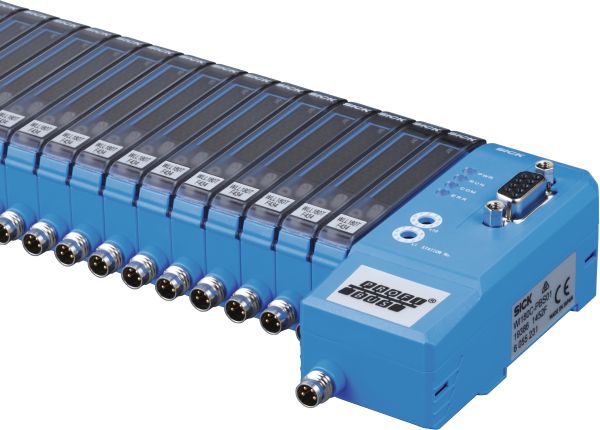At SICK, sensor data travels by bus: Fiber-optic sensors and distance sensors are connected to a WI180C-PB fieldbus module and integrated in PROFIBUS systems. The communication module enables quick access to the individual sensors and transfers their data to the control system. In automated processes, the module optimizes the transfer of parameters and the integration of the sensors into the machine network. In this way, the WI180C-PB plays a key role in ensuring fast communication between the control system and the sensors in machines and plants.
Fiber-optic sensors and distance sensors perform a wide range of tasks in automated production processes. Displacement measurement sensors from the OD Mini product family ensure precise positioning of objects and tools, for example, in the electronics and solar industry, automotive production, and machine tool production. They are also used to check the manufacturing tolerances of processed workpieces as part of the quality control process. The fiber-optic sensors of the WLL180T product family also perform a wide variety of detection tasks. Fiber-optic sensors detect all kinds of different objects even in fast processes and under difficult ambient conditions without any problems. Furthermore, adapter lenses can be used to produce very small light points so that even the smallest of objects and features can be detected with precision. These sensors are used in great numbers in positioning and detection solutions, even in situations where particularly small and sensitive objects are to be detected - for example, in the electronics and solar industry. Level measurement in the beverage or chemical industry is frequently performed by fiber-optic sensors as well. Generally, many fiber-optic sensors and distance sensors are installed - and often in inaccessible areas - for any given application. This results in a large amount of wiring work for each individual sensor and, if the sensors are in hard-to-reach places, means that any maintenance or operating work takes a great deal of effort.
In no time at all: communication between sensors and control
The WI180C-PB communication module comes to the rescue: Connecting the individual sensors to the fieldbus module enables the devices to be integrated into the machine network on the basis of PROFIBUS technology. This means that the configuration and teach-in processes can be performed by the control system via the PROFIBUS cable if the evaluation units are difficult to access. The machine operator can modify sensor settings - e.g., in the event of format changes - centrally via the control system. The integration into the machine network also enables continuous monitoring of the sensor performance: Any deviations can be identified quickly and corrected without delay. The fieldbus module enables the connection of up to 16 WLL180T devices or 8 OD Mini evaluation units with 2 sensor heads each. The sensors are connected to each other via the bus connecting system on the housing side and are fastened onto a mounting rail on the fieldbus module.
On the information superhighway of the machine, the WI180C-PB communication module acts like an actual public transport bus for the individual sensors: It takes all sensor data on board and transports it to the control system at a speed of 9.6 Kbit/s to 12 Mbit/s. This analogy even goes as far as timetables: Preprogrammed function blocks from SICK enable fast data traffic according to a schedule without any additional programming work. Alongside the significant reduction in wiring from up to 16 cables to just one, universal PROFIBUS solutions also reduce operating and repair costs in the long term, boost plant availability effectively and, ultimately, improve productivity.
- Product information: WI180C-PB, OD Mini, WLL180T
- Product portfolio: Fiber-optic sensors and fibers, Displacement measurement sensors



